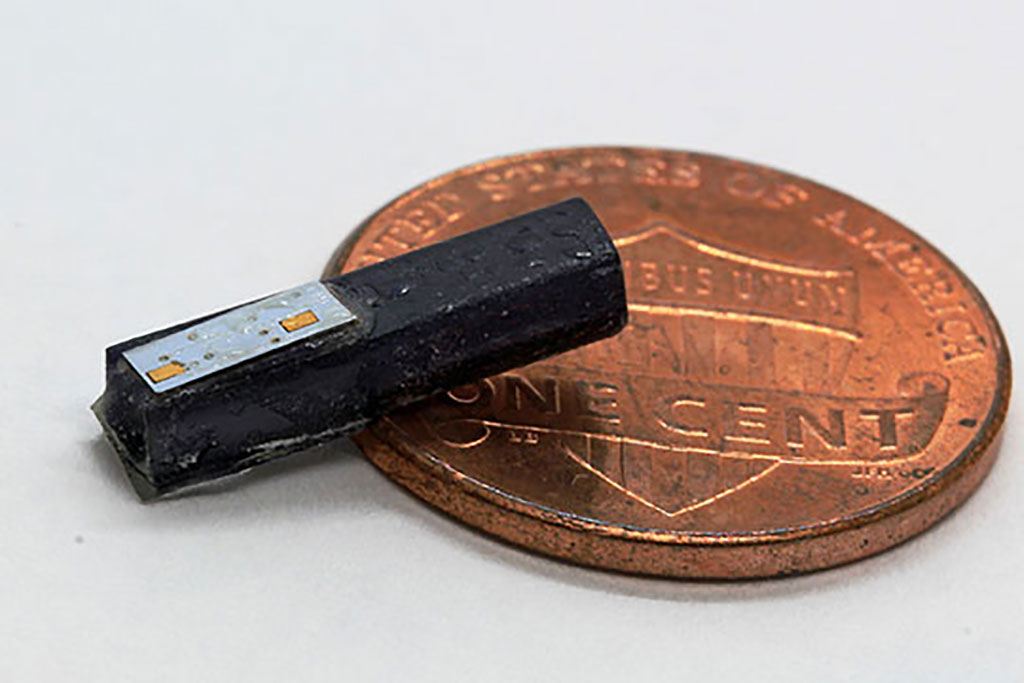Surgical Implant Could Pave Way for Real-Time Sensing of Biochemical, pH and Blood-Oxygen
|
By HospiMedica International staff writers Posted on 01 Apr 2022 |

A wireless millimetric magnetoelectric implant for the endovascular stimulation of peripheral nerves could lead to a wide range of low-risk, highly precise therapies as well as enable real-time sensing of biochemical, pH and blood-oxygen levels to provide diagnostics or support other medical devices.
Engineers at Rice University (Houston, TX, USA) have published the first proof-of-concept results from a years-long program to develop tiny, wireless devices that can treat neurological diseases or block pain. The nerve stimulators require no batteries and instead draw both their power and programming from a low-powered magnetic transmitter outside the body. The MagnetoElectric Bio ImplanT - aka ME-BIT - is placed surgically and an electrode is fed into a blood vessel toward the nerve targeted for stimulation. Once there, the device can be powered and securely controlled with a near-field transmitter worn close to the body. The researchers successfully tested the technology on animal models and found it could charge and communicate with implants several centimeters below the skin. The implant could replace more invasive units that now treat Parkinson’s disease, epilepsy, chronic pain, hearing loss and paralysis.
The ability to power the implants with magnetoelectric materials eliminates the need for electrical leads through the skin and other tissues. Leads like those often used for pacemakers can cause inflammation, and sometimes need to be replaced. Battery-powered implants can also require additional surgery to replace batteries. ME-BIT’s wearable charger requires no surgery. The researchers showed it could even be misaligned by several inches and still sufficiently power and communicate with the implant. The programmable, 0.8-square-millimeter implant incorporates a strip of magnetoelectric film that converts magnetic energy to electrical power. An on-board capacitor can store some of that power, and a “system-on-a-chip” microprocessor translates modulations in the magnetic field into data. The components are held together by a 3D-printed capsule and further encased in epoxy.
According to the researchers, the magnetic field generated by the transmitter - about 1 milliTesla - is easily tolerated by tissues. They estimated the current implant can generate a maximum of four milliwatts of power, sufficient for many neural stimulation applications. The research suggests endovascular bioelectronics like ME-BIT could lead to a wide range of low-risk, highly precise therapies. Having electrodes in the bloodstream could also enable real-time sensing of biochemical, pH and blood-oxygen levels to provide diagnostics or support other medical devices. The team ultimately hopes to employ multiple implants and communicate with them simultaneously.
“Because the devices are so small, we can use blood vessels as a highway system to reach targets that are difficult to get to with traditional surgery,” said Jacob Robinson of the Rice Neuroengineering Initiative. “We’re delivering them using the same catheters you would use for an endovascular procedure, but we would leave the device outside the vessel and place a guidewire into the bloodstream as the stimulating electrode, which could be held in place with a stent.”
“One of the nice things is that all the nerves in our bodies require oxygen and nutrients, so that means there’s a blood vessel within a few hundred microns of all the nerves,” Robinson said. “It’s just a matter of tracing the right blood vessels to reach the targets. With a combination of imaging and anatomy, we can be pretty confident about where we place the electrodes.”
Related Links:
Rice University
Latest Critical Care News
- CPR Guidelines Updated for Pediatric and Neonatal Emergency Care and Resuscitation
- Ingestible Capsule Monitors Intestinal Inflammation
- Wireless Implantable Sensor Enables Continuous Endoleak Monitoring
- Pulse Oximeter Index Offers Non-Invasive Guides for Fluid Therapy
- Wearable Patch for Early Skin Cancer Detection to Reduce Unnecessary Biopsies
- 'Universal' Kidney to Match Any Blood Type
- Light-Based Technology to Measure Brain Blood Flow Could Diagnose Stroke and TBI
- AI Heart Attack Risk Assessment Tool Outperforms Existing Methods
- Smartphone Imaging System Enables Early Oral Cancer Detection
- Swallowable Pill-Sized Bioprinter Treats GI Tract Injuries

- Personalized Brain “Pacemakers” Could Help Patients with Hard-To-Treat Epilepsy
- Microscopic DNA Flower Robots to Enable Precision Medicine Delivery
- Origami Robots to Deliver Medicine Less Invasively and More Effectively
- Improved Cough-Detection Technology Aids Health Monitoring
- AI Identifies Children in ER Likely to Develop Sepsis Within 48 Hours
- New Radiofrequency Therapy Slows Glioblastoma Growth
Channels
Critical Care
view channel
CPR Guidelines Updated for Pediatric and Neonatal Emergency Care and Resuscitation
Cardiac arrest in infants and children remains a leading cause of pediatric emergencies, with more than 7,000 out-of-hospital and 20,000 in-hospital cardiac arrests occurring annually in the United States.... Read more
Ingestible Capsule Monitors Intestinal Inflammation
Acute mesenteric ischemia—a life-threatening condition caused by blocked blood flow to the intestines—remains difficult to diagnose early because its symptoms often mimic common digestive problems.... Read more
Wireless Implantable Sensor Enables Continuous Endoleak Monitoring
Endovascular aneurysm repair (EVAR) is a life-saving, minimally invasive treatment for abdominal aortic aneurysms—balloon-like bulges in the aorta that can rupture with fatal consequences.... Read more
Wearable Patch for Early Skin Cancer Detection to Reduce Unnecessary Biopsies
Skin cancer remains one of the most dangerous and common cancers worldwide, with early detection crucial for improving survival rates. Traditional diagnostic methods—visual inspections, imaging, and biopsies—can... Read morePatient Care
view channel
Revolutionary Automatic IV-Line Flushing Device to Enhance Infusion Care
More than 80% of in-hospital patients receive intravenous (IV) therapy. Every dose of IV medicine delivered in a small volume (<250 mL) infusion bag should be followed by subsequent flushing to ensure... Read more
VR Training Tool Combats Contamination of Portable Medical Equipment
Healthcare-associated infections (HAIs) impact one in every 31 patients, cause nearly 100,000 deaths each year, and cost USD 28.4 billion in direct medical expenses. Notably, up to 75% of these infections... Read more
Portable Biosensor Platform to Reduce Hospital-Acquired Infections
Approximately 4 million patients in the European Union acquire healthcare-associated infections (HAIs) or nosocomial infections each year, with around 37,000 deaths directly resulting from these infections,... Read moreFirst-Of-Its-Kind Portable Germicidal Light Technology Disinfects High-Touch Clinical Surfaces in Seconds
Reducing healthcare-acquired infections (HAIs) remains a pressing issue within global healthcare systems. In the United States alone, 1.7 million patients contract HAIs annually, leading to approximately... Read moreHealth IT
view channel
Printable Molecule-Selective Nanoparticles Enable Mass Production of Wearable Biosensors
The future of medicine is likely to focus on the personalization of healthcare—understanding exactly what an individual requires and delivering the appropriate combination of nutrients, metabolites, and... Read moreBusiness
view channel
Philips and Masimo Partner to Advance Patient Monitoring Measurement Technologies
Royal Philips (Amsterdam, Netherlands) and Masimo (Irvine, California, USA) have renewed their multi-year strategic collaboration, combining Philips’ expertise in patient monitoring with Masimo’s noninvasive... Read more
B. Braun Acquires Digital Microsurgery Company True Digital Surgery
The high-end microsurgery market in neurosurgery, spine, and ENT is undergoing a significant transformation. Traditional analog microscopes are giving way to digital exoscopes, which provide improved visualization,... Read more
CMEF 2025 to Promote Holistic and High-Quality Development of Medical and Health Industry
The 92nd China International Medical Equipment Fair (CMEF 2025) Autumn Exhibition is scheduled to be held from September 26 to 29 at the China Import and Export Fair Complex (Canton Fair Complex) in Guangzhou.... Read more












